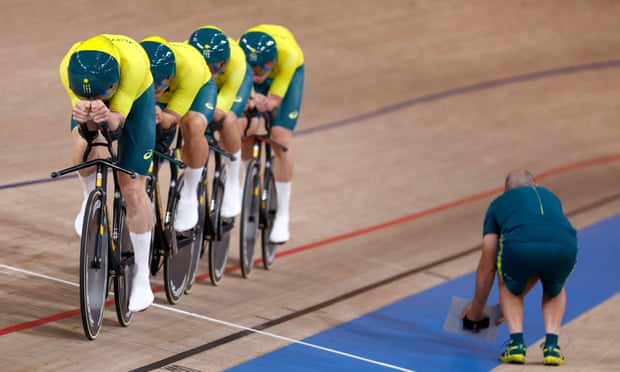A post-mortem is under way into how one of the best-funded disciplines returned just one bronze medal at the Tokyo Games
It is easy to find excuses. The pandemic had disrupted preparations. Riders had retired, another pulled out for personal reasons. At a consequential moment, equipment failed. But the thing about track cycling – particularly disciplines like the team pursuit, which is measured against the clock – is that there is no place to hide.
The Australian track cycling team went to the Tokyo 2020 Olympics in late July with high hopes. They came home deeply disappointed. Their total haul – one bronze medal, and a fortunate one at that, given they only made the men’s team pursuit medal race after Great Britain were relegated – is Australia’s worst Olympic track cycling performance since the 1980 Games.
A post-mortem is currently under way, with AusCycling convening a high performance committee to examine what went wrong and how to move forward. The peak body has also begun the search for a new performance director, to replace Englishman Simon Jones who departed post-Tokyo. Another review, led by a former air crash investigator, is seeking to understand what caused the alarming mid-race handlebar snap that ended Australia’s hopes of gold in team pursuit qualifying.
All of which rather overshadows the UCI Track World Championships, which began in France on Wednesday. Just five Australian riders will participate – Olympians who travelled to Europe after Tokyo, rather than returning home. All are endurance riders – without a full squad to contest the team pursuits, a medal or two in the individual disciplines is the best Australia might hope for. It is an anticlimactic way to begin the next era of Australian track cycling.
But it is clear that a new era must begin. Across the past four Games, Australia has won just one gold medal on the track. The discipline is among the best funded by the Australian Institute of Sport; this financial year, AusCycling received $8.3m for able-bodied high performance, behind only swimming and rowing. While that sum is split between AusCycling’s four primary disciplines – track, road, BMX and mountain-bike – track receives the lion’s share. Ongoing funding is at least partially dependent on results, and the result in Tokyo did not meet expectation.
The multi-million dollar question is why? Some will lay blame at Jones’s door – his tenure was divisive. In 2017, Michael Drapac, a financial benefactor of the sport in Australia, described Jones’s appointment as “the greatest mistake” made by Australian cycling. Others say that he oversaw a much-needed reform program and will be vindicated in time. Australia finished joint top of the medal tally at the 2019 Track World Championships, so it is not as if the team did not prosper during his tenure. But when it mattered most, his riders fell short.
The sport has a significant pipeline problem. There is an apparent lack of high-calibre talent coming through the track system. To make matters worse, the pandemic has limited international competitive opportunities for the next generation – AusCycling has had a restrictive travel policy, which meant that no team was sent to the Junior Track World Championships in September.
The women’s sprint is indicative of this challenge. The discipline was once an area of great depth for Australia, led by two-time Olympic gold medallist Anna Meares. But following the retirement of Steph Morton in 2020, and with Tokyo Olympian Kaarle McCulloch anticipated to conclude her career sooner rather than later, the field is largely vacant. While it only takes one breakthrough young star to shine in the individual events, the women’s team sprint is expanding from two riders to three. With the Paris Olympics less than three years away, it is unclear whether Australia will even be able to field a competitive team.
“There’s been too much in Australian cycling supporting the few,” says Andrew Christie-Johnston, a two-decade veteran of the sport, who runs domestic road outfit Team BridgeLane. “I’m not a fan of supporting 10 or 15 of the highest level [riders] and forgetting the rest. I think that’s what they’ve done. They really do need to start investing into the grassroots because if you make that strong, everything else will take care of itself.”
The dilemma for AusCycling is how it might reinvigorate this system, without unduly prioritising track (which, critics would argue, it has for too long – for diminishing returns). Following a tumultuous governance overhaul, the four sub-disciplines merged in Australia last year. Cycling’s only gold medal in Tokyo came in BMX freestyle, which was making its Olympic debut.
“We need a leader not a coach,” says Tom Reynolds, a former executive with the peak body. “AusCycling now represents all disciplines. Track, road, BMX, MTB – it’s too diverse for one person to be an expert on all.” Reynolds argues that a non-cycling recruit might be the best approach in this new environment. “I think perhaps someone outside of the sport might be a good choice as there’s no baggage or perceived bias.”
Where the new performance director is physically located will be symbolically significant, too. Jones was based in Adelaide, at AusCycling’s track headquarters, but basing his replacement in Melbourne, where AusCycling has its corporate headquarters, would signify a wider remit.
Whoever is chosen, and wherever they are based, the new AusCycling performance director has a big task ahead of them. Rebuilding from the disappointment of Tokyo, welcoming through a new generation of track talent, overseeing the road team on home soil at the 2022 UCI Road World Championships in Wollongong, supporting star BMX and MTB riders and focusing towards the Commonwealth Games and Paris – there is much to be done. And just like in the team pursuit, the timing provides nowhere to hide. The clock is ticking.

